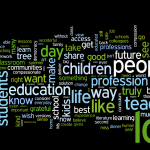“You have brains in your head. You have feet in your shoes. You can steer yourself in any direction you choose.” ~Dr. Seuss, Oh, The Places You’ll Go!
Educators, riddle me this: How many of us actually send our personal children to attend the schools where we teach? Seriously, if we asked this question during a staff meeting on our campuses, and we asked our colleagues to stand up if any of their personal children have attended the schools in which we teach… how many of us would be standing? What if we broadened the question to: How many of us educators live within the neighborhoods or boundaries of the schools/districts where we teach? If so, do we send our personal children to the schools within those school/district boundaries?
These questions have been on my mind as I’ve allowed my personal kiddo to use the brains in her head and the feet in her shoes to steer her high school education. During her 8th grade year, she thought about attending the high school where I taught: a large, urban campus on the outer edge of our neighborhood district boundary. She happily entertained this thought as she could ride into work with me and had already been on the campus many times over the years to help me clean and decorate classrooms during summers. But then… the future freshmen nights started… and then she wanted to attend some of them… and then… I let her.
The result? She didn’t end up attending the school where I taught or our neighborhood school. As an incoming freshman, she had multiple passions. One was to learn many different languages, so we seriously considered a foreign language magnet program within my own school district. Another was to further her music career (she plays 3 different instruments and sings), so she applied to a performing arts public charter school and got accepted. After a few weeks of continued thought, however, she realized that she didn’t want to have to pick/stick to one track of singing, piano, or stringed instrument for 4 years – so she declined the offer. After attending a frosh night at a nearby public high school, in another district just outside of my district boundary (but actually closer to our house), she fell in love with a Career and Technical Education (CTE) music program that would allow her to be in multiple bands, try her hand at songwriting, and learn what it takes to record and produce music in a sound studio – right on a campus that she could walk to. As a parent who saw her passion fully ignited by this prospect, I supported my daughter’s decision to take advantage of our state’s open enrollment laws to attend a school of her choice.
Sacrilegious? Perhaps. Four years later, however, this child of mine is making music and performing in multiple venues under the expert guidance of her music teacher – and guess what? She now wants to become a music teacher herself to bring this kind of program to more schools in Arizona. Was it the brilliant lessons on Shakespeare or calculus that caused her to wake up and go to school each day? The inner-English teacher in me would love to say that it was. Truthfully, though she enjoys many aspects of her academic coursework once she gets onto campus, it’s the holistic and autonomous music elective classes that inspire her to forge out of bed in the morning. In a competitive market for education, my professional self knows that the neighborhood school within my district-boundary has lost the money that my daughter would have brought to it. As a mother, I also know that the school my daughter chose to attend has been a great fit for her passions.
So how can we cultivate a public education system that inspires students to choose to attend our neighborhood schools? As a diehard urban and public educator, I feel dicey even writing this blog about how school choice has benefitted my personal child. Yet I lean into discomfort to be transparent and to, hopefully, generate constructive dialogue about the necessity of creating a viable and relevant portfolio of options within our public schools. If students could dream big, what might they want their neighborhood schools to look and sound like to meet the intersecting needs of their passions and academics?
I certainly know that my daughter’s future is much brighter because she is following her passions; I also know that the futures of many more of Arizona’s students will be brighter as she enters college next year to become a music educator – which will require a new kind of support from her educator-mother… (I smell more blog posts coming on this topic).










Comments 10
This is such an important question– especially in Northern Arizona. Flagstaff only has two public high schools but SIX charter high schools. In small communities especially, school choice often divides social and ethnic population. It becomes difficult for public schools to academically compete with less funding and community support.
Teaching underrepresented students in a 50+ FRL school is the most valuable thing I have ever done, because I know these kids NEED great teachers. This passion is so important to me that if my school demographic were to change, I would seek a school with demonstrated need.
AND YET, if I had my own children, I can’t confidently say I would send them to my school. I mean, I [think] I would– but have doubts. I see that too often teachers lower their standards for lower kids because they think that is what will help them improve. So ironically, it’s not the kids, and it’s not the school, it’s the quality and exposure to rigorous teaching that would help me make the decision.
Totally agree with your first paragraph.
We never considered sending my kids to my school. I live out of the district, go in early, often stay late, and we couldn’t see adding hours to their day for no visible returns, compared to our neighborhood school which is quite good. Plus, when my kids were elementary ages – years ago, there were some teachers in the primary grades at my school we didn’t have confidence in. l’ve got zero issue with school choice when it comes to judgement by students and parents and think each family knows best what right for them. But I do have issues with school choice fairness when it comes to how schools are judged by politicians and judges.
Last year was the first year we would have had the option for one of my kids to go to the school where I teach. However, it was also the first year since kindergarten that he had the opportunity to attend the neighborhood school and see what it was like to walk or ride the bike to school and make friends in the neighborhood. He had been in various self-contained situations before that, to which he was bussed. Our neighborhood junior high is not at all high-achieving, and there are many problems associated with a high rate of poverty. Because of that, we have had our issues. However, he has begun to be more of a neighborhood citizen, offering yard work services to neighbors and interacting socially with some of the kids who walk home in the same direction or live along the way. Having moved several times recently, these things are important. My daughter also walks to school.
Honestly, even though I support our neighborhood schools, I don’t know what will happen next year for high school.
I believe in school choice, actually. I can’t imagine telling a child or parent that the child cannot attend a school with a program that could ignite his/her passion. But I agree that we must build a strong set of public school choices. What I see in most of the school choice created by charters is a devil’s bargain. Money funneled from public k-12 schools could have been used to create excellent magnet programs of all types, but it gets used to create selective schools that often lack inclusivity, services and opportunities beyond the academic. The CTE program your daughter found sounds amazing. Why couldn’t all schools become magnets, and benefit from an investment of resources and leadership?
This year, I left my previous position where I was completely happy in a program I had worked hard to create…to now work in my neighborhood school where my one-year old daughter will attend some day! I struggled with these same questions, wanted to teach at her school, and yet wanted her in a local school near her neighborhood friends. Making the switch was so scary, but teaching close to home has been AMAZING! I run into my students and their parents at the grocery store now. Super cool! When I had early morning conferences a few weeks ago, I went back home until it was time to go back for the kids. It was so scary to take the plunge and make the transfer, but I’m so excited to be getting to know my daughter’s future teachers and contributing to the culture of her future school. Of course, I feel blessed to have this uncommon opportunity–and respect the tough decision that all parents make when choosing schools for their children It’s great when a school is the right fit for a child. All kids deserve that! (And teachers, too!)
It’s great when a school is the right fit for a child. All kids deserve that! (And teachers, too!)
Alaina thanks for the openness in this post. I think its important for parents and students to make decisions that are in their best interest and have a lasting impact.
Thanks for sharing the process & decision making you and your daughter went through in order to support her growth. I agree that there should be a focus on how public schools can offer a wider variety of opportunities to students, to allow neighborhood schools to meet the needs of the students in their neighborhoods.
This blog has made me think further about school choice, and I am also curious if school choice is more prevalent in grades 6-12, versus K-5.
Thanks for engaging my mind!
Alaina you know I am digging the Dr. Seuss reference This is a conversation that needs to happen. Thank you for braving these dicey waters. As Danielle alluded to, if we really want to ensure every child in this country gets an excellent education, we really need to commit to supporting our public schools. We all need to be in this together. We should be looking at how we can meet the needs of each child and tailor education to fit appropriately. It should not be a surprise to anyone that kids and parents alike (many parents like you) are more satisfied when they can choose the options that work best for them—especially when they can completely design their child’s education, and that’s a good thing. Like Amethyst, my main concern with school choice is the voucher system. Under most voucher bills, private schools can take taxpayer money and still deny admission to any student they choose. Unlike public schools, some private schools can and do discriminate against students based on various criteria, including disability, economic background, academic record, English language ability or even disciplinary history. I believe public funds should pay only for public schools that are open to all children and are accountable. The bottom-line: we, all stakeholders, legislators etc, have to work together to ensure every student has every opportunity to succeed, regardless of school choice.
This is a conversation that needs to happen. Thank you for braving these dicey waters. As Danielle alluded to, if we really want to ensure every child in this country gets an excellent education, we really need to commit to supporting our public schools. We all need to be in this together. We should be looking at how we can meet the needs of each child and tailor education to fit appropriately. It should not be a surprise to anyone that kids and parents alike (many parents like you) are more satisfied when they can choose the options that work best for them—especially when they can completely design their child’s education, and that’s a good thing. Like Amethyst, my main concern with school choice is the voucher system. Under most voucher bills, private schools can take taxpayer money and still deny admission to any student they choose. Unlike public schools, some private schools can and do discriminate against students based on various criteria, including disability, economic background, academic record, English language ability or even disciplinary history. I believe public funds should pay only for public schools that are open to all children and are accountable. The bottom-line: we, all stakeholders, legislators etc, have to work together to ensure every student has every opportunity to succeed, regardless of school choice.
Excellent Post!!
I think the decision for where to place our children to attend school is as relevant to K-8 as it is 9-12. I know so many parents, educators and non-educators, who have that similar pro-con conversations with their families to determine where to go and what makes the school the best fit for their child. I think the increase of the amount of charter schools and the open enrollment policy of AZ public schools provide that choice for parents, and it’s nice to have the opportunity to tailor the educational benefits for our children.
Thank you for being willing to talk about this topic. This has always been a struggle for me as a parent. My daughter has attended three schools in my former district. The one I taught at for K-1, another in district, not our “home” school 2-5, and know her home middle school in a blended learning program that she is excelling at as a 6th grader. With recent career shifts for both y husband and I, and a potential move on the horizon, do I pull her from this program she loves and is thriving in to find her niche all over again? I don’t know.. Like you, I have always been a proponent of public community school, but I would never shame or judge anyone who works to find the best fit for their child. I am so glad my district has afforded my daughter the amazing opportunities and teachers she has experienced over the last 7 years. Thank you for starting this conversation.
Thank you for your openness in addressing this topic. It actually reminded me of a conversation I had with a K-12 policymaker in North Carolina regarding public schools. He had chosen to let his children attend the public school in their neighborhood in lieu of the private school in the area. Since his work involves public education, he told me that he would feel like a hypocrite if he did not send his own children to the very schools he advocates so passionately for. On the other hand, he shared that many of his public education focused coworkers had chosen to send their children to private schools.
I think the issue you are exploring in this post is an incredibly difficult one to make judgments on. I cannot fully blame an educator (or a proponent for public education) for making the decision they feel is best for their child’s academic success. It is unfortunate that this is a decision that parents need to make – in a perfect world, a child could get the same caliber of education regardless of what kind of school they go to.
Great post!